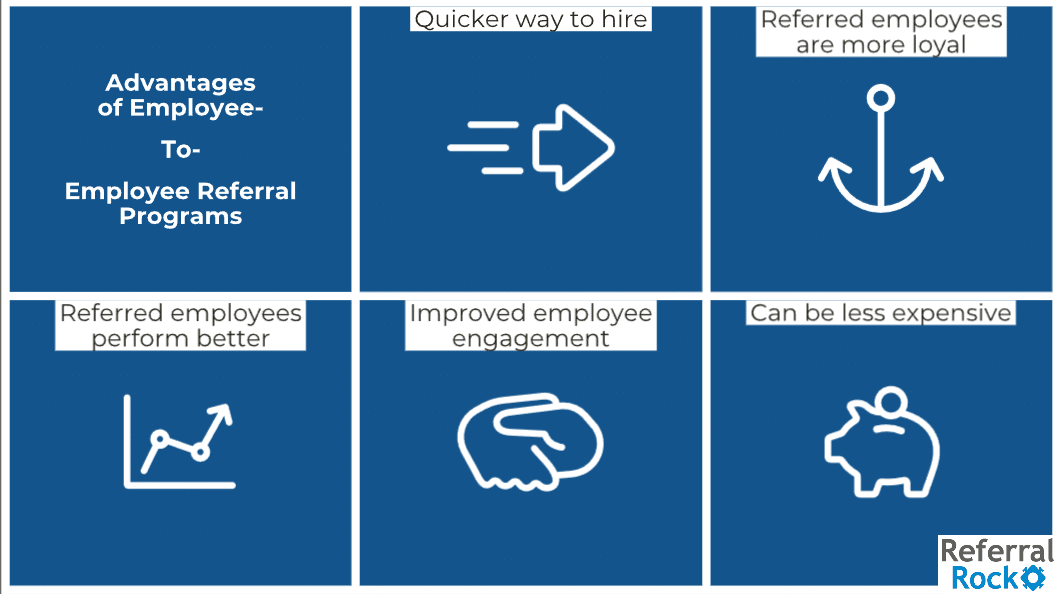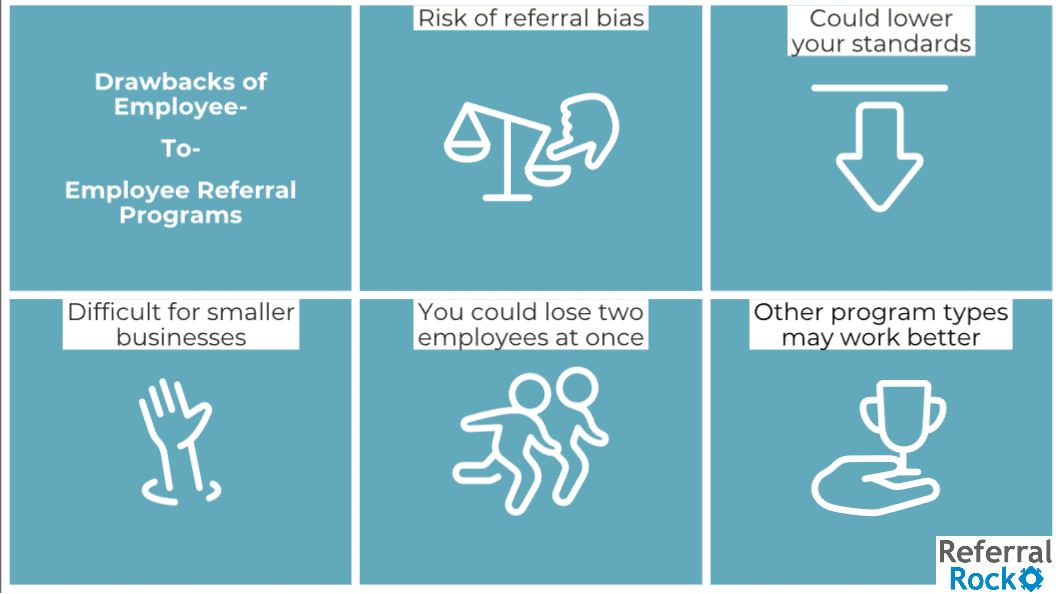There are both pros and cons of employee referrals as part of your hiring practice. Employee-to-employee referral programs help you find candidates to fill job openings, but they don’t work for every business. Deciding whether you need an employee-to-employee referral program takes some figuring out. You’ll want to know if the style of the recruitment referral program is the right fit for your business.
An employee-to-employee referral program is one where your employees recommend potential candidates to join the company. This type of program taps into the network of your current employee for new hires that are a good fit for the company.
We’re taking a closer look at the pros and cons of an employee referral system to help you decide if it’s the right recruitment practice for you.
Advantages of an employee referral program
There are many benefits of employee referral programs. Companies who have an employee referral program as part of their hiring practice, and who are executing it correctly, see the advantages one brings.
Employees who are referred by an existing employee often experience a streamlined hiring process. They are more loyal and have better job performance with high engagement, and the employer experiences a better retention rate. In addition, employee referral programs tend to be cost-effective and reduce expenses related to high turnover and related job postings.
Let’s take a closer look at the advantages of an employee referral program:
You’ll hire employees more quickly
Employee referral programs accelerate the hiring process – you can significantly reduce the time it takes to hire new employees. Referred candidates typically move through the hiring process faster than those sourced from job boards or career sites. Employers could see a remarkable 25% difference in time saved. An employee who comes through the employee referral program moves through the entire process within 29 days compared to 39-55 days.
Employees, who are already knowledgeable about the company culture, are equipped to identify and refer ideal candidates who are great fits. This opens the door for individuals who are a perfect fit for vacant positions to come to you, and reduces the time it takes to fill roles.
In addition, when your current employees are incentivized to refer suitable candidates, that increases your odds of finding the employees you need in a timely fashion. Plus, referred candidates are more likely to sign on when you offer the job.
Referred employees are more loyal
Employees who are referred are more likely to stick around. This is good news when it comes to your retention rate. At the end of the first year, retention rates for referred employees are 43%, as opposed to 33% for employees found on career sites.
Referred employees stick with you longer than other employees because working with a peer they know leads to higher satisfaction.
They are not only happier employees, but their friend who referred them invests in their success along with you. This supports both the employee and the employer. The trust they have in their friend transfers to having trust in the company.
Referred employees perform better
People tend to be careful when it comes to referring candidates to their own workplace. This leads to higher-quality hires in comparison to using job boards, as a result of an employee carefully considering candidates before referring them.
Referred candidates are prequalified by their peer, and their peer naturally becomes a mentor to them. This relationship leads to better job performance. Referred workers are roughly 25% more profitable than non-referred workers.
You’ll improve employee engagement
Implementing an employee referral program has a profound impact on employee engagement within your organization. The employee referral program invites employees to actively participate in the recruitment process. This demonstrates a sense of trust and recognition of the employees, and they feel valued. An employee referral program makes them feel like they play an integral role in the company’s success.
The referral program becomes a meaningful way for employees to contribute to the growth of the organization.
Offering referral rewards as incentives encourages greater involvement from staff. This sparks enthusiasm and camaraderie among colleagues. Plus, the workplace becomes an engaging environment that is more fulfilling and satisfying. Employees look forward to working alongside friends and like-minded individuals they’ve referred.
Employee referral programs foster positive workplace culture and bolster productivity. So, an employee referral program is a powerful tool for engaging a workforce.
Referrals cost less
Another stand-out advantage of employee referral programs is cost-efficiency. In an employee referral program, you’ll only pay for software, and then pay for referral rewards when an employee is hired.
By leveraging your employee’s networks, you skip the expenses associated with job advertising and subscription fees for various job portals. The cost of referral software and referral rewards tends to be less than maintaining multiple job board subscriptions and recruiters. You’ll also only pay when referrals bring a positive ROI. This is in direct contrast with job boards and recruiters, which you have to pay for before you see results
Employee referral programs also enable employers to reduce engaging with third-party recruitment agencies to identify qualified candidates. Instead, current employees provide prequalified, vetted individuals who they recommend. Employees feel empowered to provide candidates who are best fit for the company and the available position.
Disadvantages of employee referral programs
Although employee referral programs offer significant advantages, there are a few drawbacks. It’s good to understand potential pitfalls when considering implementing this type of program.
We’ll take a closer look at some of the disadvantages of employee referral programs next, they are:
There’s the risk of referral bias
One downfall of an employee referral program is the potential to create an inadvertent lack of diversity in the workforce. Referrers recommend people from their network. Generally, this will be people of similar backgrounds with similar skills and values.
Referral bias such as this decreases diversity in your workforce. If you’re not diligent, an employee referral program may unintentionally rule out job seekers with different backgrounds such as different races, genders, nationalities, abilities, and even perspectives.
You could end up lowering your standards
In a typical recruitment process, employers are rigorous when it comes to screening and conducting comprehensive interviews to ensure suitable new hires. The same level of scrutiny may not be applied to employee referrals.
Those in hiring positions may become more relaxed when it comes to the screening process. If a candidate is referred by an employee that has a strong reputation, recruiters may skip important steps.
Sometimes, recruiters trust referred applicants too much because a colleague recommended them, and don’t screen them as thoroughly. This could lead you to end up with a lower-performing employee, or one who doesn’t have the needed skills and values for the environment.
Companies can safeguard against these pitfalls by maintaining a strong and consistent approach to evaluating potential new employees. When each applicant, referred or not, is reviewed with the same rigorous screening throughout the recruitment process, employers understand their strengths and weaknesses equally and will hire the best-fit person for the job.
They’re hard for small companies to maintain
For small companies, employee referral programs can pose challenges to maintain effectively. This is because a small business may not need to fill job postings regularly. In this case, it might not be time to invest in an employee referral program.
Employee referral programs can be cost-effective for larger businesses, but when it comes to a small business, and hiring needs are infrequent, they may end up spending more than any savings it provides.
Employee referral programs require ongoing maintenance unless you’re actively seeking new hires. This makes it less worthwhile than it is for larger companies with ongoing recruitment needs.
You could lose two employees at once
Referred employees tend to be more loyal, but that doesn’t mean they won’t ever leave. A lot of their loyalty is based on their trust in the friend who referred them.
If the referrer gets a better opportunity or leaves for other reasons, there is a risk of the once-loyal new hire following their friend and leaving too.
Alternatives to employee-to-employee referral programs
If an employee referral program isn’t the right fit for you right now, there are alternative approaches to leverage your employee’s support for your recruitment needs. You may consider:
- An employee-customer referral program, where employees are incentivized and rewarded for bringing new clients and customers. As a business, you benefit from tapping into your employee’s connections with their credibility, and you expand your customer base.
- Create an employee ambassador program. This will involve training and empowering employees to become brand representatives. As ambassadors, they play a crucial role in promoting your business. This could be done online or offline. Brand ambassadors share their positive experiences and advocate for your products and services. This is a great strategy to increase brand awareness, build trust and credibility with potential new clients, and increase employee engagement.
- Develop an open referral program. This is a flexible approach that allows employees and customers to refer new leads to your business. It opens up the referral process to loyal customers and business partners. This is one way you can tap into a broad network of potential new candidates or clients.
All of these alternatives are particularly well-suited for smaller businesses. They offer a reliable return on investment and foster organic growth through the collective efforts of engaged employees.
Conclusion
Although there are many benefits of employee referral programs, they aren’t always the best fit for every business. There are many pros and cons of employee referral programs to consider.
Employee referral programs provide cost-efficient benefits to your business. You’ll directly benefit from a faster hiring process, and better employee engagement, loyalty, and retention to name a few highlights.
Referral Rock provides the best employee referral software to help businesses maximize their employee programs programs, whether you plan on recruiting talented new hires, attracting more customers, or both! Contact us to learn how an employee referral program could work for you.





